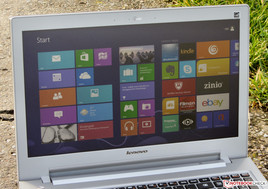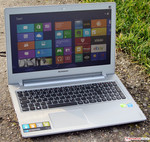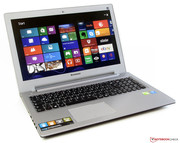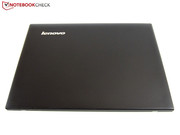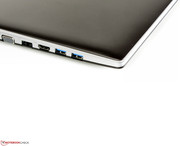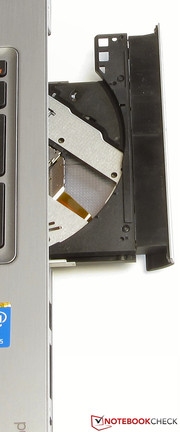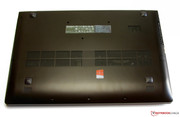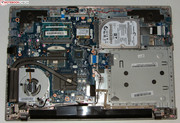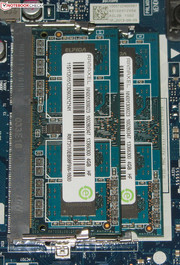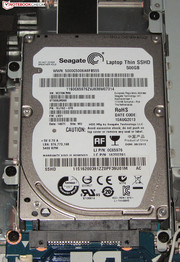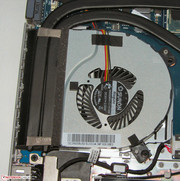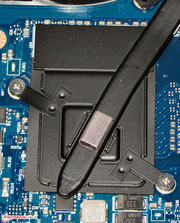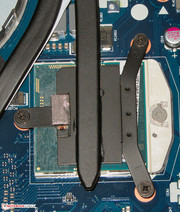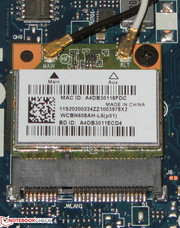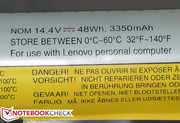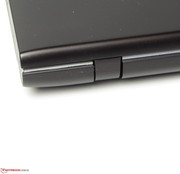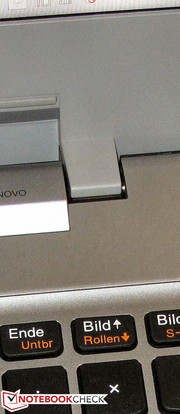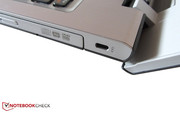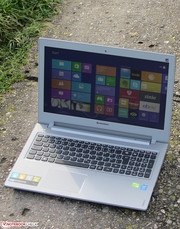Review Lenovo IdeaPad Z510 Notebook

For the original German review, see here.
The IdeaPad Z510 series consists of a number of 15.6-inch mid-range multimedia notebooks. The Z510 models are successors of the Z500 notebook series. With the IdeaPad Z500-MBYG2GE (Core i7-3632QM, GeForce GT 645M) we reviewed a member of this series. While the Z500 models still featured Ivy Bridge CPUs, Lenovo uses Haswell CPUs in the Z510 series. The Z500 model reviewed by us achieved a total rating of "Good" (79%). In theory, the Z510 should perform better, as the computer's battery life should be longer and its waste heat and system noise should be lower because of its Haswell CPU. Our review reveals whether this is actually true.
We compare the notebook to the following competitors: Asus N56VB-S4050H (Core i7-3630QM, GeForce GT 740M) and Acer Aspire E1-572G (Core i5-4200U, Radeon HD 8750M). Both of them belong to the same category as the IdeaPad and are very similarly equipped. The Aspire model reviewed by us only featured an HD display (1366x768 pixels), but it is also available with a matte Full HD display.
At first glance the Lenovo Z510 series appears to use the same case as the Z500 series. But, this is not completely true. The computers are slightly different, but they also have a lot in common. This review will give a detailed description of the differences. Please refer to the review of the Z500 for information about case, input devices, and connectivity.
Case
The case of the Z510 is about 5 mm wider and about 2 mm longer than the Z500's, but it got only significantly less than 1 mm higher. In general, the two series share the same shape, materials, surfaces, colors, build quality, and stability. The recess of the battery looks slightly different. While the Z500's was completely rounded, the Z510's is flattened on one side.
Connectivity
None of the three competitors have a surprising connectivity. All of them come with at least one USB 3.0 port. The IdeaPad features two, the Asus even has four ports. Users of both computers particularly benefit from these if they transfer much data between two external hard drives. Compromises have to be accepted in Ethernet. The Lenovo only features Fast Ethernet, while the two competitors come with Gigabit Ethernet. The interface layout of the Z510 slightly differs from the Z500's, but it is not ideal on both notebooks: The ports are on both sides of the palm rests.
Operating System and Recovery
The IdeaPad uses Windows 8 (64-bit) as the operating system. A Windows 8 DVD is not included. The system can be repaired with Lenovo's One-Key Recovery system, which can also be used to recover the factory state. In order to run it, you simply need to press the One-Key Recovery button (left side beside the vent holes) when the notebook is turned off. The notebook boots and displays a menu, which allows accessing the BIOS. Select "System Recovery" from the menu.
Maintenance
Alike the Z500, the Z510 is not especially easy to maintain. In order to get to the hardware and the battery, you have to open the case. The first step is to remove the keyboard. For this purpose, loosen the three rear screws on the underside of the case. Afterwards, insert a screwdriver into one of the screw holes and carefully push out the keyboard with it. Please note: The keyboard is connected to the motherboard by a ribbon cable. Now there is limited access to the fan which allows cleaning it.
Removing the keyboard will uncover several screws. First of all loosen and remove the retaining screw of the DVD burner. Afterwards loosen the other screws. Attention: One of them is hidden beneath a Lenovo sticker. In the next step, remove all screws of the underside of the case. Three of them are at the front edge, three at the edge of the DVD shaft and four are hidden beneath the rubber feet, which can be easily removed as they are not glued. Once you removed all screws, you can remove the bottom tray. A putty knife can be used for this task. But be careful: The underside is also held by a number of plastic hooks, which break easily.
Once you removed the bottom tray, you will gain access to the RAM, hard drive, WLAN module, battery, and fan. The latter can be removed for cleaning. The IdeaPad features two RAM slots, which are both occupied by a 4 GB module. Only 2.5-inch hard drives with a height of 7 mm will fit into the computer. The battery can be removed too. It is fixed by two screws and connected to the motherboard by a plug. It is even possible to replace the CPU, which sits in a socket.
Input Devices
Apart from a small difference, the keyboard of the Z510 and the Z500 are identical: The Z510's keyboard does not have a light. Please refer to the review of the IdeaPad Z500 for information about keyboard and touchpad.
Display
Lenovo uses a matte 15.6-inch display with a native resolution of 1920x1080 pixels in the IdeaPad. The N56VB features the same display type, while the Aspire model we reviewed came with a glossy HD display (1366x768 pixels), but it is also available with a matte Full HD display. The average brightness of the Z510 of 294.6 cd/m² is good. The Asus notebook (360.4 cd/m²) is significantly brighter. The Aspire (182.3 cd/m²) is far behind the competitors.
| |||||||||||||||||||||||||
Brightness Distribution: 73 %
Center on Battery: 317 cd/m²
Contrast: 327:1 (Black: 0.97 cd/m²)
ΔE ColorChecker Calman: 8.52 | ∀{0.5-29.43 Ø4.77}
ΔE Greyscale Calman: 10.06 | ∀{0.09-98 Ø5}
48.76% AdobeRGB 1998 (Argyll 1.6.3 3D)
52.5% AdobeRGB 1998 (Argyll 3D)
74.4% sRGB (Argyll 3D)
50.8% Display P3 (Argyll 3D)
Gamma: 2.51
CCT: 10564 K
Contrast (327:1) and black value (0.97 cd/m²) of the IdeaPad are not convincing. The Aspire (415:1, 0.47 cd/m²) and especially the N56VB (765:1, 0.52 cd/m²) perform significantly better. The display of the Z510 does not cover AdobeRGB or sRGB. The coverage is about 48.8% (AdobeRGB) and 66.6% (sRGB). These color spaces are important for professional image editing.
We measured the screen against sRGB and identified an average DeltaE-2000 deviation (target space: sRGB) of just under 9. Only blue, yellow-orange, and yellow are in the target range (DeltaE < 5). The display is significantly bluish.
Our photo proves that the notebook can be used outdoors. High brightness and the matte surface make it possible.
Performance
With the new IdeaPad Z510 series, Lenovo offers some mid-priced 15.6-inch multimedia notebooks. Apart from everyday applications like video playback or Skype, these devices can also run demanding tasks like 3D games or video editing. Currently, our test device costs about 650 to 720 Euros (~$877 to ~$971). Lenovo offers several models with different processors, hard drive capacities and operating systems. At the time of testing, the cheapest model (IdeaPad Z510 59400165) features the same hardware as our test sample, but it comes without Windows OS. Its price is about 630 Euros (~$850).
Processor
With the Core i5-4200M, our IdeaPad is powered by a standard volt (not ULV) CPU. The dual-core CPU is based on Intel's latest Haswell architecture and clocks in at 2.5 GHz. The Turbo can increase the clock rate to up to 3 GHz (both cores) or 3.1 GHz (only one core). Its direct Ivy Bridge predecessor is called Core i5-3210M. Both CPUs have the same base and turbo clocks. Thanks to Haswell improvements, the Core i5-4200M should perform about 10% better.
The processor clocks at 3 GHz during the single thread tests of Cinebench. Every now and then, the clock rate of one core is increased to 3.1 GHz. The CPU runs at 3 GHz during the multi-thread tests. The IdeaPad can keep up with the Asus (Core i7-3630QM, GeForce GT 740M) in single threaded tests, while the processor of the N56VB profits from its two additional cores and its higher Turbo rates during multi-threaded tasks. The Aspire (Core i5-4200U, Radeon HD 8750M) is slower than both competitors. This is not surprising as it features a ULV model of the Core i5-4200M with a significantly lower clock rate.
The results of the three devices are close in the GL tests. The IdeaPad and the N56VB feature the same GPU. The performance of the Radeon core in the Aspire is about on par.
System Performance
The system runs smoothly. We did not observe big delays. The very good results in the PCMark benchmarks confirm our impression. The Aspire (Core i5-4200U, Radeon HD 8750M) and N56VB (Core i7-3630QM, GeForce GT 740M) perform significantly worse as they lack an SSD cache, which the Z510 features.
| PCMark Vantage Result | 8145 points | |
| PCMark 7 Score | 4214 points | |
| PCMark 8 Home Score Accelerated | 3091 points | |
| PCMark 8 Creative Score Accelerated | 3388 points | |
| PCMark 8 Work Score Accelerated | 4426 points | |
Help | ||
Storage Devices
Lenovo equipped the IdeaPad with a hybrid hard drive from Seagate with a revolution speed of 5400 rpm and a capacity of 500 GB. It addition, it features an SSD cache (8 GB). The CrystalDiskMark results show that the write rates of the hard drive are significantly higher than the read rates. In addition, the sequential read rate of 51.31 MB/s is unusually low. The average transfer rate reported by HD Tune of 88.9 MB/s is significantly better. Nevertheless, we did not feel that the hard drive is unusually slow.
Graphics card
Lenovo uses an Optimus solution consisting of Intel's HD Graphics 4600 and GeForce GT 740M for rendering. The Intel chip is relatively frugal and is used for everyday tasks and on battery. The GT 740M GPU is used during demanding tasks, e. g. 3D games. Both cores support at least DirectX 11. The GeForce is a mid-range GPU. Its base clock is about 980 MHz. The Turbo can increase the clock rate to 1058 MHz and the notebook also uses it.
In the 3DMark benchmarks the Asus notebook (Core i7-3630QM, GeForce GT 740M) performs better than the IdeaPad, although they are equipped with the same graphics card, as the N56VB profits from its fast quad-core CPU. So, the lead of the N56VB decreases if the results do not depend heavily on CPU performance, e. g. in 3DMark 2011. The same is true for the Aspire (Core i5-4200U, Radeon HD 8750M). The Radeon GPU of the Acer is about on par with the GeForce GT 740M, but the Acer cannot always keep up with the IdeaPad in the 3DMark benchmarks, as it features the weakest CPU of the three.
| 3DMark 06 Standard Score | 10361 points | |
| 3DMark Vantage P Result | 6592 points | |
| 3DMark 11 Performance | 2061 points | |
| 3DMark Ice Storm Standard Score | 52373 points | |
| 3DMark Cloud Gate Standard Score | 5375 points | |
| 3DMark Fire Strike Score | 1147 points | |
Help | ||
| Lenovo IdeaPad Z510 GeForce GT 740M, 4200M, Seagate ST500LM000 Solid State Hybrid Drive | Acer Aspire E1-572G-54204G75Mnkk Radeon HD 8750M, 4200U, TOSHIBA MQ01ABD075 | Asus N56VB-S4050H GeForce GT 740M, 3630QM, WDC Scorpio Blue WD7500BPVT-80HXZT3 | Lenovo IdeaPad Y510p GeForce GT 750M SLI, 4700MQ, Samsung SpinPoint M8 HN-M101MBB | |
|---|---|---|---|---|
| 3DMark | 1% | 31% | 123% | |
| 1280x720 Ice Storm Standard Score (Points) | 52373 | 50492 -4% | 67664 29% | 83684 60% |
| 1280x720 Cloud Gate Standard Score (Points) | 5375 | 5433 1% | 8226 53% | 12684 136% |
| 1920x1080 Fire Strike Score (Points) | 1147 | 1209 5% | 1269 11% | 3143 174% |
Gaming Performance
Thank to Haswell CPU and GeForce GPU the IdeaPad also performs well in computer games. Most games can be played in HD resolution (1366x768 pixels) with medium to high quality. The computer can also run current top titles like Battlefield 4 and Call of Duty: Ghosts. But, Batman: Arkham Origins caused problems. As the game always crashed when loading contents, we cannot report any frame rates.
If you require a significantly higher gaming performance, you could consider the Lenovo IdeaPad Y510P (Core i7-4700MQ, GeForce GT 750M SLI), which is able to run many games in Full HD and maximum quality. However, at about 1200 to 1300 Euros (~$1619 to ~$1754) it is also significantly more expensive than the Z510. A scaled-down Y510P model with Core i5-4200M and GeForce GT 755M is available and costs less than 800 Euros (~$1079), but it comes without Windows operating system.
| low | med. | high | ultra | |
|---|---|---|---|---|
| World of Warcraft (2005) | 63.8 | 36.2 | ||
| Crysis - GPU Benchmark (2007) | 78.4 | 39.4 | ||
| Crysis - CPU Benchmark (2007) | 64.7 | 32.5 | ||
| Trackmania Nations Forever (2008) | 86.6 | 30.3 | ||
| Resident Evil 5 (2009) | 68.4 | 32.5 | ||
| Battlefield: Bad Company 2 (2010) | 65.1 | 46.6 | ||
| Batman: Arkham City (2011) | 93 | 59 | 31 | |
| The Elder Scrolls V: Skyrim (2011) | 54.9 | 37.8 | 28 | |
| Anno 2070 (2011) | 125.9 | 57.2 | 32.9 | |
| Ghost Recon: Future Soldier (2012) | 41 | 14.6 | ||
| Tomb Raider (2013) | 97 | 47 | 25.9 | |
| F1 2013 (2013) | 114 | 85 | 76 | 30 |
| Battlefield 4 (2013) | 52.2 | 35.3 | 21.5 | |
| Call of Duty: Ghosts (2013) | 61.9 | 42.5 | 19.4 |
| Lenovo IdeaPad Z510 GeForce GT 740M, 4200M, Seagate ST500LM000 Solid State Hybrid Drive | Acer Aspire E1-572G-54204G75Mnkk Radeon HD 8750M, 4200U, TOSHIBA MQ01ABD075 | Asus N56VB-S4050H GeForce GT 740M, 3630QM, WDC Scorpio Blue WD7500BPVT-80HXZT3 | Lenovo IdeaPad Y510p GeForce GT 750M SLI, 4700MQ, Samsung SpinPoint M8 HN-M101MBB | |
|---|---|---|---|---|
| Tomb Raider | 4% | 25% | 256% | |
| 1024x768 Low Preset (fps) | 97 | 92.6 -5% | 111.4 15% | |
| 1366x768 Normal Preset AA:FX AF:4x (fps) | 47 | 45.5 -3% | 57.9 23% | 142.7 204% |
| 1366x768 High Preset AA:FX AF:8x (fps) | 25.9 | 30.8 19% | 35.3 36% | 105.8 308% |
Emissions
System Noise
The noise ranges from 30.9 to 32.4 dB while idle. These values are alright. The N56VB (29.8 to 32.8 dB) is on par, while the Aspire (31.3 to 33.6 dB) is significantly louder. During medium load (3DMark06) and full load (stress test: Prime95 and Furmark) the noise of the Z510 increases to 37.6 and 39.1 dB respectively. The Asus (38.2 and 39.2 dB) is on par again. The Aspire (35.3 and 39.8 dB) is only on par with the competitors under full load. Overall, the Z510 works quieter than its predecessor. But the DVD burners of the two computers are very loud, especially when seeking.
Noise level
| Idle |
| 30.9 / 30.9 / 32.4 dB(A) |
| HDD |
| 31.7 dB(A) |
| DVD |
| 46.2 / dB(A) |
| Load |
| 37.6 / 39.1 dB(A) |
 | ||
30 dB silent 40 dB(A) audible 50 dB(A) loud |
||
min: | ||
Temperature
None of the three competitors gets especially warm while idle. They are all in the green. Under load the case temperature of the IdeaPad exceeds 40 °C. The same is true for the Asus, albeit to a lesser extent. The Aspire gets hottest, which is surprising as it is equipped with a ULV CPU.
During the stress test (Prime95 and Furmark run for at least one hour) the CPU clocks at 3 GHz on mains. The GPU starts with full Turbo speed (1058 MHz), but the clock rate falls to 980 MHz after about 3 minutes and remains there constantly. However, the stress test is not an everyday scenario. The results of our gaming and applications benchmarks do not show any anomalies. The CPU temperature leveled off at about 87 °C on mains.
When the stress test is run on battery, the CPU clocks at 2.5 GHz and the graphics core runs at minimum speed (135 MHz). The latter surprised us and we reran 3DMark 2011 and the Tomb Raider benchmark on battery. The results of the two benchmarks confirm that the computer cannot really be used for gaming on battery. The 3DMark 2011 result falls to 372 points and the Tomb Raider benchmark reaches frame rates of 20.7 fps (min.) and 9.6 fps (medium).
(±) The maximum temperature on the upper side is 45 °C / 113 F, compared to the average of 36.9 °C / 98 F, ranging from 21.1 to 71 °C for the class Multimedia.
(±) The bottom heats up to a maximum of 44.3 °C / 112 F, compared to the average of 39.2 °C / 103 F
(+) In idle usage, the average temperature for the upper side is 28.2 °C / 83 F, compared to the device average of 31.3 °C / 88 F.
(+) The palmrests and touchpad are reaching skin temperature as a maximum (34.8 °C / 94.6 F) and are therefore not hot.
(-) The average temperature of the palmrest area of similar devices was 28.7 °C / 83.7 F (-6.1 °C / -10.9 F).
Speakers
The stereo speakers of the Z510 are on the same place on the underside of the case as the Z500's. Contrary to the Z500, Lenovo advertises with the manufacturer of the Z510's speakers: JBL. This is also printed on the case and a sticker. The sound of the speakers is enjoyable and voluminous and the ears will not even hurt after prolonged listening. We were a little surprised that the sound is also that good without activated Dolby Home Theatre Software (preinstalled). Activating it will improve the sound even more. Users can use preinstalled sound profiles or experiment with individual settings. If you are not satisfied by the sound of the speakers, you can connect external speakers or headphones.
Energy Management
Power Consumption
While idle the power consumption ranges from 7 to 10.4 Watt. Considering that the IdeaPad is equipped with a conventional mobile CPU and a dedicated graphics chip, these values are pleasing. The Aspire (6.2 to 10.6 Watt) is even more frugal. The N56VB (10.8 to 25.1 Watt) is significantly more power hungry. Under medium load (3DMark06) and full load (stress test: Prime95 and Furmark), the power consumption of the Z510 increases to 57.9 and 55.3 Watt respectively. The second value is lower, as the computer does not run at full speed under full load. The Asus has a power consumption of 75.7 and 82 Watt respectively. But, it should be considered that this computer features a powerful quad-core CPU. Thanks to its ULV CPU, the Aspire (40.8 and 50.7 Watt respectively) is the most frugal.
| Off / Standby | |
| Idle | |
| Load |
|
Key:
min: | |
Battery Life
The battery of the IdeaPad lasts 6:56 h when idle. The battery life of the N56VB (4:48 h) is significantly shorter. Neither computer can keep up with the Aspire (9:02 h). We test the idle scenario with the Battery Eater Reader's test with minimum display brightness, active energy saving profile, and disabled radio modules. Under load the IdeaPad achieves a battery life of 1:29 h. The Asus and the Aspire perform worse, but the latter's battery life is only a few minutes shorter. We tested the battery life under load with the Battery Eater Classic test with maximum brightness, profile "Maximum performance", and enabled radio modules.
The WLAN test ends after 3:27 h on the Lenovo. The N56VB (3:40 h) and especially the Aspire (4:26 h) keep running longer. This test automatically loads web pages every 40 seconds. The energy saving profile is selected and the display brightness is set to about 150 cd/m². DVD playback stops after 2:43 h on the IdeaPad. The N56VB (2:46 h) is on par. The Aspire (3:21 h) has the longest battery life again. The DVD test is run with energy saving profile (or higher if the DVD does not play smoothly), maximum brightness and disabled radio modules.
Although the Aspire's battery has the smallest capacity, the Acer takes the lead in battery life (Lenovo: 48 Wh, Asus: 56 Wh, Acer: 37 Wh). The ULV CPU pays off here.
Verdict
The IdeaPad Z510 has a good system and gaming performance. Thanks to its hybrid hard drive the computer works rather fast. The battery life is acceptable and the power consumption is moderate. In addition, Lenovo packs the components in a relatively slim, robust case with good build quality. We also liked the bright Full HD display and the matte surface a lot. Unfortunately, it has a low contrast and is bluish. Furthermore, the Z510 inherited several weaknesses from its predecessor: The DVD burner is loud and the notebook only features a Fast Ethernet port. In addition, the device is not easy to maintain.
Consider the Asus N56VB if you require as much CPU performance as possible. Thanks to its Core i7 processor, it performs better in this aspect. However, it also costs more than the IdeaPad. A scaled-down N56VB model with Core i5-3230M processor for about 700 Euros (~$944) would be another alternative. In addition, the Asus is easier to maintain. The Acer Aspire E1-572G can be considered if battery life is important besides computer and gaming performance. The Aspire is the best compromise of all three here and you don't even have to do without a Full HD display. Our test device with matte Full HD display is currently available for about 600 Euros (~$809). So, the Aspire is the cheapest of the three. Information about its Full HD display is available in our review of the Acer Aspire E1-572.









